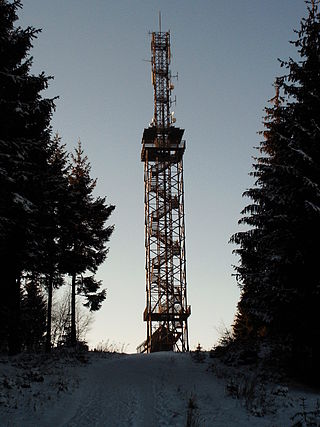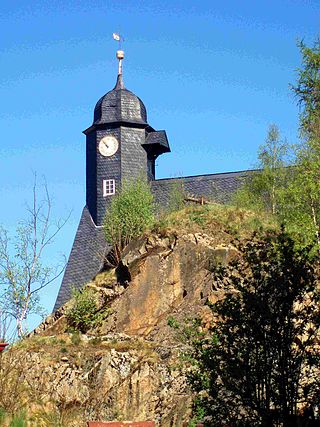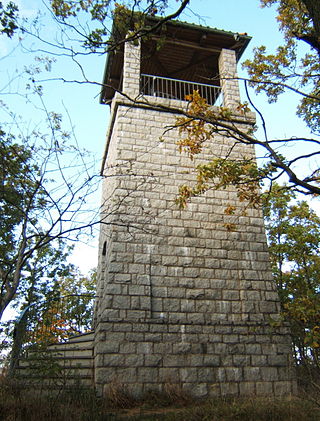
The Berliner Funkturm or Funkturm Berlin is a former broadcasting tower in Berlin, Germany. Constructed between 1924 and 1926 to designs by the architect Heinrich Straumer, it was inaugurated on 3 September 1926, on the occasion of the opening of the third Große Deutsche Funkausstellung in the grounds of the Messe Berlin trade fair in the borough of Charlottenburg-Wilmersdorf. Nicknamed der lange Lulatsch, the tower is one of the best-known points of interest in the city of Berlin and, while no longer used for broadcasting purposes, it remains a protected monument.

The Joseph Cross is an observation tower in form of a double cross on the 580-metre-high Großer Auerberg near Stolberg (Harz), Germany. The Joseph Cross is a steel framework construction with a height of 38 metres and a weight of 125 tons, which was built between 20 April 1896 and 9 August 1896. The Joseph Cross was closed for visitors from 1987 to 1990, before being refurbished and reopened.

Blankenburg (Harz) is a town and health resort in the district of Harz in Saxony-Anhalt, Germany, at the north foot of the Harz Mountains, 12 miles (19 km) southwest of Halberstadt.

Hasselfelde is a town in the district of Harz, in Saxony-Anhalt, Germany. It is in the eastern Harz, approximately 17 km south of Wernigerode. Since 1 January 2010 it has been part of the town of Oberharz am Brocken. Its population is 1,941 (2021).

At 971 m above sea level (NN) the Wurmberg is the second highest mountain in the Harz and the highest in Lower Saxony (Germany).

The Schalke is a mountain, 762 m above sea level (NN), in the Upper Harz in the German state of Lower Saxony. It lies in Goslar district north of Clausthal-Zellerfeld and west of Schulenberg.

The Wittekindsberg is a hill, 281.48 m above sea level (NN), which forms the easternmost peak of the Wiehen Hills and is also the western guardian of the Weser gorge, the Porta Westfalica, in North Rhine-Westphalia (Germany).

The Hanskühnenburg is a mountain hut in the Harz mountains. It is located at a height of 811 m (2,661 ft) above sea level in fields known as Auf dem Acker, or simply Acker, in the middle of the Harz National Park and has its own observation tower. Its name comes from the legendary Hanskühnenburg Crag 300 metres to the northwest, which was visited on 14 August 1784 by Johann Wolfgang von Goethe. Opposite the tower are the Hanskühnenburg Rocks that are relatively small by comparison with the Klippe. A bronze plaque was mounted on these rocks in 1999 to commemorate Goethe's visit. In front of the Hanskühnenburg Rocks, a monument was erected in 1924 to Albert Leo Schlageter. It has since fallen over and is rather weathered.

The Carlshaushöhe is a mountain, 626.3 m, in the Harz in the German state of Saxony-Anhalt.

The Ziegenkopf is a hill, 400.7 m above sea level (NN), near Blankenburg in the Harz mountains in the German state of Saxony-Anhalt.

Trautenstein is a village in the borough of Oberharz am Brocken in the district of Harz in the German state of Saxony-Anhalt. Formerly an independent municipality, it was merged into the town Hasselfelde in 2002, which was merged into Oberharz am Brocken in 2010. Its population is 390 (2021).

A large number of monuments were erected in Germany in honour of Emperor William I. As early as 1867 the Berlin sculptor, Friedrich Drake, had created the first equestrian statue, that portrayed William I as the King of Prussia. To date the Prussian Monument Institute has recorded:
Emperor towers or Kaiser towers are monuments that were built up to 1918 in honour of the German emperors William I, Frederick III and Wilhelm II in the German Empire or for Emperor Franz Josef in Austria-Hungary.

The Homburg Watchtower is an observation tower on the site of a Germanic refuge castle (Fliehburg) near the Hexentanzplatz above the town of Thale in the Harz Mountains of central Germany.

The Jagdschloss Windenhütte is an historic former hunting lodge now serving as a hotel and daytrippers' restaurant in the Harz Mountains of central Germany.

The Austberg, also called the Augsberg or Augstberg, is a low hill, 292 m above sea level (NN), in the northern Harz Foreland near the village of Benzingerode in the district of Harz in the German state of Saxony-Anhalt.

The Emperor William Monument, near the town of Porta Westfalica in the North Rhine-Westphalian county of Minden-Lübbecke, is a colossal monument above the Weser gorge of Porta Westfalica, the "Gateway to Westphalia". It was erected to honour the first German Emperor, William I (1797–1888), by the then Prussian Province of Westphalia between 1892 and 1896 and emerged against the background of a rising German national identity. The monument, which is around 88 metres (289 ft) high, is classified as one of Germany's national monuments.
Kaiser Wilhelm Tower or Emperor William Tower is the name of various observation towers, mostly in Germany, which are given that name, although some of them also have alternative names:

The Emperor William Tower or Kaiser Wilhelm Tower is an observation tower near Holzminden in the German state of Lower Saxony, built in honour of the German emperor, William I. It was erected in 1908 and is 17 metres high.
The Freinberg is a mountain with an elevation of 405 meters above sea level, situated in the urban area of the Upper Austrian capital, Linz. Historically, this mountain plateau and the forested ridge to the south were known by different names, including Galgenberg and Jägermayrwald. The Freinberg offers panoramic views of almost the entire city of Linz.

















